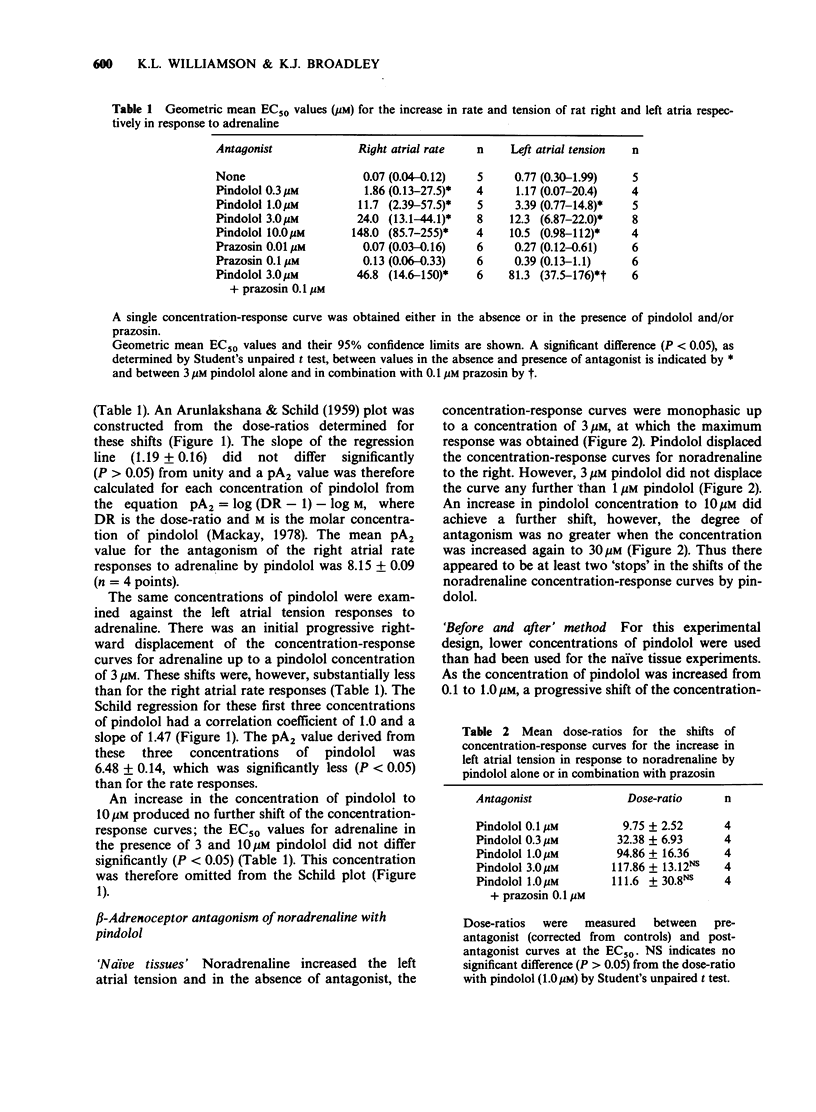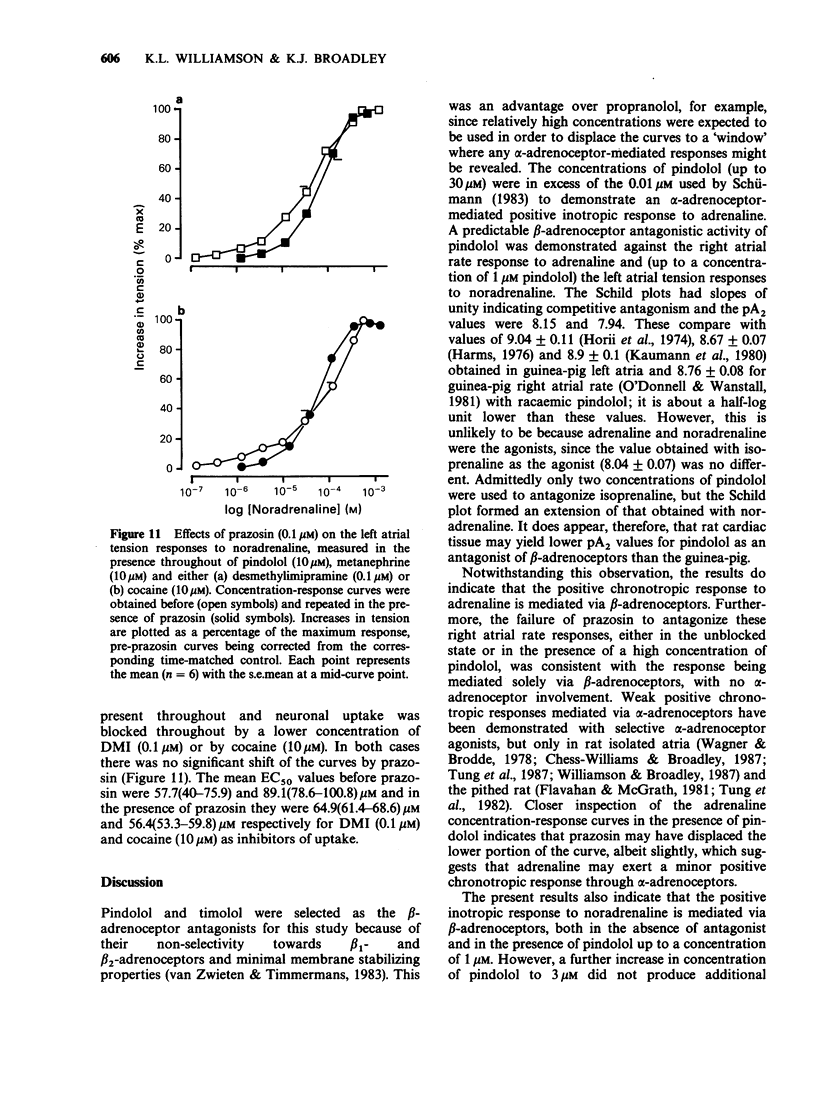Abstract
1. The positive inotropic responses of rat paced left atria to adrenaline and noradrenaline were recorded. Desmethylimipramine (DMI, 1 microM) and metanephrine (10 microM) were initially present throughout. 2. The positive chronotropic responses of spontaneously beating right atria to adrenaline were used as a reference. In these, pindolol, in increasing concentrations, caused progressive shift of the concentration-response curves to the right, which yielded a pA2 value (8.15) compatible with antagonism of beta-adrenoceptors. 3. The left atrial tension responses to adrenaline showed an initial progressive displacement by pindolol (up to 3 microM) which gave an unexpectedly low pA2 value (6.48). However, with further increases in pindolol concentration there was no additional shift of the curve. In the presence of pindolol (3 microM), prazosin (0.1 microM) displaced the curve to the right but the pA2 value derived from this shift (7.75) was less than expected for alpha 1-adrenoceptor antagonism. 4. When the experiments in the presence of pindolol (3 microM) were repeated in the absence of DMI, prazosin displaced the concentration-response curves for adrenaline-induced left atrial tension to a greater extent and the pA2 value (8.76) was now compatible with adrenaline stimulating typical alpha 1-adrenoceptors. 5. The concentration-response curves for noradrenaline-induced left atrial tension were also progressively displaced to the right by pindolol (0.1, 0.3 and 1.0 microM). These concentrations yielded a Schild plot of unity slope and a pA2 value of 7.94 +/- 0.04. This was not significantly different from the pA2 value of 8.02 +/- 0.07 determined for pindolol against isoprenaline in the left atria, which indicates a normal interaction of noradrenaline with beta-adrenoceptors in the absence and presence of low concentrations of pindolol. 6. A further increase in the concentration of pindolol to 3 microM failed to induce an additional shift of the noradrenaline curves, whether a 'before and after' antagonist or a 'naïve tissue' design was adopted. Similarly, the rightwards shift of the concentration-response curves by timolol reached a limit as the concentration was increased. In all cases the limit of shift occurred at a noradrenaline EC50 value of 5-10 microM. 7. At the limit of beta-adrenoceptor antagonism, prazosin and dibenamine did not displace the noradrenaline curves further. The residual inotropic response to noradrenaline therefore appeared to be mediated via neither alpha- nor beta-adrenoceptors. 8. DMI, in the absence of beta-blockade, produced the potentiation of adrenaline and noradrenaline expected of a neuronal uptake inhibitor.(ABSTRACT TRUNCATED AT 400 WORDS)
Full text
PDF














Selected References
These references are in PubMed. This may not be the complete list of references from this article.
- ARUNLAKSHANA O., SCHILD H. O. Some quantitative uses of drug antagonists. Br J Pharmacol Chemother. 1959 Mar;14(1):48–58. doi: 10.1111/j.1476-5381.1959.tb00928.x. [DOI] [PMC free article] [PubMed] [Google Scholar]
- Aass H., Skomedal T., Osnes J. B. Demonstration of an alpha adrenoceptor-mediated inotropic effect of norepinephrine in rabbit papillary muscle. J Pharmacol Exp Ther. 1983 Aug;226(2):572–578. [PubMed] [Google Scholar]
- Aass H., Skomedal T., Osnes J. B., Fjeld N. B., Klingen G., Langslet A., Svennevig J., Semb G. Noradrenaline evokes an alpha-adrenoceptor-mediated inotropic effect in human ventricular myocardium. Acta Pharmacol Toxicol (Copenh) 1986 Jan;58(1):88–90. doi: 10.1111/j.1600-0773.1986.tb00075.x. [DOI] [PubMed] [Google Scholar]
- Angelakos E. T., King M. P., Millard R. W. Regional distribution of catecholamines in the hearts of various species. Ann N Y Acad Sci. 1969 Jan 31;156(1):219–240. doi: 10.1111/j.1749-6632.1969.tb16730.x. [DOI] [PubMed] [Google Scholar]
- Arch J. R., Ainsworth A. T., Cawthorne M. A., Piercy V., Sennitt M. V., Thody V. E., Wilson C., Wilson S. Atypical beta-adrenoceptor on brown adipocytes as target for anti-obesity drugs. Nature. 1984 May 10;309(5964):163–165. doi: 10.1038/309163a0. [DOI] [PubMed] [Google Scholar]
- Ask J. A., Stene-Larsen G. Functional alpha 1-adrenoceptors in the rat heart during beta-receptor blockade. Acta Physiol Scand. 1984 Jan;120(1):7–13. doi: 10.1111/j.1748-1716.1984.tb07366.x. [DOI] [PubMed] [Google Scholar]
- Bond R. A., Charlton K. G., Clarke D. E. Evidence for a receptor mediated action of norepinephrine distinct from alpha- and beta-adrenoceptors. Naunyn Schmiedebergs Arch Pharmacol. 1986 Nov;334(3):261–266. doi: 10.1007/BF00508780. [DOI] [PubMed] [Google Scholar]
- Bond R. A., Charlton K. G., Clarke D. E. Responses to norepinephrine resistant to inhibition by alpha and beta adrenoceptor antagonists. J Pharmacol Exp Ther. 1986 Feb;236(2):408–415. [PubMed] [Google Scholar]
- Bond R. A., Clarke D. E. A response to isoprenaline unrelated to alpha- and beta-adrenoceptor agonism. Br J Pharmacol. 1987 Jul;91(3):683–686. doi: 10.1111/j.1476-5381.1987.tb11262.x. [DOI] [PMC free article] [PubMed] [Google Scholar]
- Chess-Williams R. G., Broadley K. J. Examination of cardiac alpha-adrenoceptors from pharmacological responses and radioligand binding. Comparison of rat and guinea pig tissues. J Pharmacol Methods. 1987 Sep;18(2):111–122. doi: 10.1016/0160-5402(87)90003-9. [DOI] [PubMed] [Google Scholar]
- Digges K. G., Summers R. J. Characterization of postsynaptic alpha-adrenoceptors in rat aortic strips and portal veins. Br J Pharmacol. 1983 Jul;79(3):655–665. doi: 10.1111/j.1476-5381.1983.tb10002.x. [DOI] [PMC free article] [PubMed] [Google Scholar]
- Doggrell S. A., Paton D. M. Effects of prazosin and phentolamine on responses to field stimulation and to noradrenaline in vas deferens and anococcygeus muscle of the rat. Arch Int Pharmacodyn Ther. 1978 Jun;233(2):209–220. [PubMed] [Google Scholar]
- Doxey J. C., Smith C. F., Walker J. M. Selectivity of blocking agents for pre-and postsynaptic alpha-adrenoceptors. Br J Pharmacol. 1977 May;60(1):91–96. doi: 10.1111/j.1476-5381.1977.tb16752.x. [DOI] [PMC free article] [PubMed] [Google Scholar]
- Flavahan N. A., McGrath J. C. alpha 1-adrenoceptors can mediate chronotropic responses in the rat heart. Br J Pharmacol. 1981 Jul;73(3):586–588. doi: 10.1111/j.1476-5381.1981.tb16791.x. [DOI] [PMC free article] [PubMed] [Google Scholar]
- Hamed A. T., Johnson T. D., Charlton K. G., Clarke D. E. Pharmacological characterization of alpha-adrenoreceptor subtypes in rat isolated thoracic aorta. J Auton Pharmacol. 1983 Dec;3(4):265–273. doi: 10.1111/j.1474-8673.1983.tb00544.x. [DOI] [PubMed] [Google Scholar]
- Harms H. H. Isoproterenol antagonism of cardioselective beta adrenergic receptor blocking agents: a comparative study of human and guinea-pig cardiac and bronchial beta adrenergic receptors. J Pharmacol Exp Ther. 1976 Nov;199(2):329–335. [PubMed] [Google Scholar]
- Hawthorn M. H., Broadley K. J. Evidence from use of neuronal uptake inhibition that beta 1-adrenoceptors, but not beta 2-adrenoceptors, are innervated. J Pharm Pharmacol. 1982 Oct;34(10):664–666. doi: 10.1111/j.2042-7158.1982.tb04697.x. [DOI] [PubMed] [Google Scholar]
- Horii D., Kawada T., Takeda K., Imai S. Comparison of beta-adrenergic blocking activities of propranolol, isopropylmethoxamine, sotalol, practolol, alprenolol, pindolol, oxprenolol and D-32 in the atria and trachea of the guinea-pig. Arzneimittelforschung. 1974 Sep;24(9):1275–1277. [PubMed] [Google Scholar]
- Karliner J. S., Barnes P., Hamilton C. A., Dollery C. T. alpha 1-Adrenergic receptors in guinea pig myocardium: identification by binding of a new radioligand, (3H)-prazosin. Biochem Biophys Res Commun. 1979 Sep 12;90(1):142–149. doi: 10.1016/0006-291x(79)91601-2. [DOI] [PubMed] [Google Scholar]
- Kaumann A. J., McInerny T. K., Gilmour D. P., Blinks J. R. Comparative assessment of beta-adrenoceptor blocking agents as simple competitive antagonists in isolated heart muscle: similarity of inotropic and chronotropic blocking potencies against isoproterenol. Naunyn Schmiedebergs Arch Pharmacol. 1980 Apr;311(3):219–236. doi: 10.1007/BF00569402. [DOI] [PubMed] [Google Scholar]
- Langer S. Z., Trendelenburg U. The effect of a saturable uptake mechanism on the slopes of dose-response curves for sympathomimetic amines and on the shifts of dose-response curves produced by a competitive antagonist. J Pharmacol Exp Ther. 1969 May;167(1):117–142. [PubMed] [Google Scholar]
- MacKay D. How should values of pA2 and affinity constants for pharmacological competitive antagonists be estimated? J Pharm Pharmacol. 1978 May;30(5):312–313. doi: 10.1111/j.2042-7158.1978.tb13237.x. [DOI] [PubMed] [Google Scholar]
- Mackay I. R., Rose N. R., Carnegie P. R. Germ-line deletion of genes coding for self-determinants. Nature. 1980 Nov 20;288(5788):302–303. doi: 10.1038/288302b0. [DOI] [PubMed] [Google Scholar]
- O'Donnell S. R., Wanstall J. C. Pharmacological approaches to the characterization of beta-adrenoreceptor populations in tissues. J Auton Pharmacol. 1981 Sep;1(4):305–312. doi: 10.1111/j.1474-8673.1981.tb00460.x. [DOI] [PubMed] [Google Scholar]
- O'Donnell S. R., Wanstall J. C. The importance of choice of agonist in studies designed to predict beta 2 : beta 1 adrenoceptor selectivity of antagonists from pA2 values on guinea-pig trachea and atria. Naunyn Schmiedebergs Arch Pharmacol. 1979 Sep;308(3):183–190. doi: 10.1007/BF00501381. [DOI] [PubMed] [Google Scholar]
- Purdy R. E., Krueger C. G., Young S. Evidence for nonclassical alpha adrenoceptor blockade by prazosin in isolated rabbit blood vessels. Life Sci. 1980 Dec 8;27(23):2187–2195. doi: 10.1016/0024-3205(80)90383-5. [DOI] [PubMed] [Google Scholar]
- Schümann H. J., Brodde O. E. Demonstration of alpha-adrenoceptors in the rabbit heart by [3H]-dihydroergocryptine binding. Naunyn Schmiedebergs Arch Pharmacol. 1979 Sep;308(3):191–198. doi: 10.1007/BF00501382. [DOI] [PMC free article] [PubMed] [Google Scholar]
- Schümann H. J., Endo M., Wagner J. Positive inotropic effects of phenylephrine in the isolated rabbit papillary muscle mediated both by alpha- and beta-adrenoceptors. Naunyn Schmiedebergs Arch Pharmacol. 1974;284(2):133–148. doi: 10.1007/BF00501118. [DOI] [PubMed] [Google Scholar]
- Schümann H. J. What role do alpha- and beta-adrenoceptors play in the regulation of the heart? Eur Heart J. 1983 Jan;4 (Suppl A):55–60. doi: 10.1093/eurheartj/4.suppl_a.55. [DOI] [PubMed] [Google Scholar]
- Seeman P. Brain dopamine receptors. Pharmacol Rev. 1980 Sep;32(3):229–313. [PubMed] [Google Scholar]
- Skomedal T., Aass H., Osnes J. B., Fjeld N. B., Klingen G., Langslet A., Semb G. Demonstration of an alpha adrenoceptor-mediated inotropic effect of norepinephrine in human atria. J Pharmacol Exp Ther. 1985 May;233(2):441–446. [PubMed] [Google Scholar]
- Skomedal T., Osnes J. B. Qualitative differences between the inotropic responses in rat papillary muscles to alpha-adrenoceptor and beta-adrenoceptor stimulation by both noradrenaline and adrenaline. Acta Pharmacol Toxicol (Copenh) 1983 Jan;52(1):57–67. doi: 10.1111/j.1600-0773.1983.tb01076.x. [DOI] [PubMed] [Google Scholar]
- Steinberg S. F., Bilezikian J. P. Identification and characterization of alpha 1 adrenergic receptors in rat myocardium with a new iodinated radioligand, [125I]IBE 2254. J Mol Cell Cardiol. 1982 Oct;14(10):601–610. doi: 10.1016/0022-2828(82)90146-8. [DOI] [PubMed] [Google Scholar]
- Stene-Larsen G. Characterization of the atrial alpha-receptor of the rat as a subgroup of the postsynaptic alpha-adrenoceptor. Gen Pharmacol. 1980;11(6):575–581. doi: 10.1016/0306-3623(80)90094-4. [DOI] [PubMed] [Google Scholar]
- Tayo F. M. Are there alpha-adrenoceptors in the young chick atria? Br J Pharmacol. 1984 Feb;81(2):289–291. doi: 10.1111/j.1476-5381.1984.tb10077.x. [DOI] [PMC free article] [PubMed] [Google Scholar]
- Timmermans P. B., de Jonge A., van Meel J. C., Mathy M. J., van Zwieten P. A. Influence of nifedipine on functional responses in vivo initiated at alpha 2-adrenoceptors. J Cardiovasc Pharmacol. 1983 Jan-Feb;5(1):1–11. doi: 10.1097/00005344-198301000-00001. [DOI] [PubMed] [Google Scholar]
- Tung L. H., Rand M. J., Drummer O. H., Louis W. J. Positive chronotropic responses produced by alpha-adrenoreceptors in the pithed rat. J Auton Pharmacol. 1982 Dec;2(4):217–233. doi: 10.1111/j.1474-8673.1982.tb00512.x. [DOI] [PubMed] [Google Scholar]
- Tung L. H., Rand M. J., Louis W. J. Calcium antagonists inhibit positive chronotropic responses to alpha 1-adrenoceptor activation in rat isolated atria. Eur J Pharmacol. 1987 Jan 13;133(2):177–184. doi: 10.1016/0014-2999(87)90148-8. [DOI] [PubMed] [Google Scholar]
- Turker R. K., Khairallah P. A. Demethylimipramine (desipramine), an alpha-adrenergic blocking agent. Experientia. 1967 Apr 15;23(4):252–252. doi: 10.1007/BF02135664. [DOI] [PubMed] [Google Scholar]
- U'Prichard D. C., Greenberg D. A., Sheehan P. P., Snyder S. H. Tricyclic antidepressants: therapeutic properties and affinity for alpha-noradrenergic receptor binding sites in the brain. Science. 1978 Jan 13;199(4325):197–198. doi: 10.1126/science.202024. [DOI] [PubMed] [Google Scholar]
- Wagner J., Brodde O. E. On the presence and distribution of alpha-adrenoceptors in the heart of various mammalian species. Naunyn Schmiedebergs Arch Pharmacol. 1978 May;302(3):239–254. doi: 10.1007/BF00508293. [DOI] [PubMed] [Google Scholar]
- Wagner J., Schümann H. J., Knorr A., Rohm N., Reidemeister J. C. Stimulation by adrenaline and dopamine but not by noradrenaline of myocardial alpha-adrenoceptors mediating positive inotropic effects in human atrial preparations. Naunyn Schmiedebergs Arch Pharmacol. 1980 May;312(1):99–102. doi: 10.1007/BF00502581. [DOI] [PubMed] [Google Scholar]
- Williams R. S., Lefkowitz R. J. Alpha-adrenergic receptors in rat myocardium. Identification by binding of [3H]dihydroergocryptine. Circ Res. 1978 Nov;43(5):721–727. doi: 10.1161/01.res.43.5.721. [DOI] [PubMed] [Google Scholar]
- Williamson K. L., Broadley K. J. Characterization of the alpha-adrenoceptors mediating positive inotropy of rat left atria by use of selective agonists and antagonists. Arch Int Pharmacodyn Ther. 1987 Feb;285(2):181–198. [PubMed] [Google Scholar]


